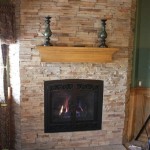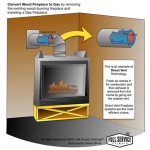Concrete Block Outdoor Fireplace: Construction, Design, and Considerations
An outdoor fireplace serves as a focal point in open-air living spaces, extending the usability of patios and gardens into cooler seasons. Constructing such a feature with concrete blocks offers a cost-effective, durable, and aesthetically versatile solution. This article explores the various aspects of building a concrete block outdoor fireplace, detailing design considerations, construction processes, and crucial elements to ensure safety and longevity.
Concrete blocks, also known as cinder blocks or CMUs (Concrete Masonry Units), are manufactured rectangular prisms composed of concrete and aggregate materials. These blocks are robust, fire-resistant, and readily available in various sizes and textures, making them suitable for constructing numerous outdoor structures. The modular nature of concrete blocks simplifies the building process, reducing cutting and fitting complexities compared to other masonry materials. Furthermore, the inherent thermal mass of concrete helps retain and radiate heat, contributing to the efficiency of the fireplace.
Material Selection and Preparation
The initial phase involves selecting the appropriate concrete blocks for the project. Standard blocks, typically measuring 8 inches high, 16 inches long, and 8 inches wide, are commonly used for the main structure. However, different sizes and specialized blocks, such as corner blocks or cap blocks, may be necessary depending on the design's complexity. It's vital to ensure that the blocks conform to local building codes and are suitable for outdoor use, typically requiring a higher strength rating and resistance to freeze-thaw cycles in colder climates.
In addition to concrete blocks, the following materials are essential:
- Mortar: Type S mortar is recommended for its high compressive strength and bonding capabilities, essential for structural integrity and weather resistance.
- Firebricks: These are specifically designed to withstand high temperatures and are used to line the firebox, protecting the concrete blocks from direct exposure to flames.
- Firebrick Mortar: A special mortar formulated to withstand the extreme heat within the firebox, ensuring the firebricks remain securely bonded.
- Gravel: Used as a base layer for drainage and stability.
- Reinforcement Bars (Rebar): Added within the mortar joints to strengthen the structure and resist cracking.
- Concrete Footing: A poured concrete foundation provides a stable and level base for the fireplace.
- Chimney Liner: A stainless steel or clay flue liner inserted inside the chimney to protect the concrete from corrosive combustion byproducts and ensure proper draft.
- Cap: A decorative cap to protect the chimney from rain and snow.
Before commencing construction, prepare the site by clearing vegetation and debris. Excavate the area for the concrete footing, ensuring it extends beyond the footprint of the fireplace. The depth of the footing will depend on local frost line requirements to prevent heaving and cracking during freezing temperatures. Pour the concrete footing and allow it to cure completely before starting the block laying process.
Construction Process: Laying the Foundation and Walls
The construction begins with laying the first course of concrete blocks on the cured concrete footing. Use a level to ensure that the first course is perfectly horizontal, as this will serve as the basis for the entire structure. Apply a thick bed of mortar to the footing and carefully position each block, checking for alignment and levelness. Use a rubber mallet to gently tap the blocks into place. Insert rebar vertically into the hollow cores of the blocks and fill the cores with concrete for added strength and stability. Repeat this process for each subsequent course, staggering the joints between the blocks to create a strong, interlocking pattern. Apply mortar evenly to both the horizontal and vertical joints, ensuring a complete seal to prevent moisture penetration.
As the walls rise, integrate reinforcement bars horizontally into the mortar joints every few courses. This helps to distribute stress and prevent cracking due to thermal expansion and contraction. Pay close attention to the design of the firebox opening. Ensure it's properly sized for efficient combustion and easy access for adding fuel. Construct the firebox walls using firebricks, applying firebrick mortar to create tight, heat-resistant joints. The firebricks should completely line the firebox, protecting the surrounding concrete blocks from direct flame exposure.
The construction of the chimney requires careful planning to ensure proper draft and smoke evacuation. The chimney should be tall enough to clear surrounding structures and create sufficient updraft. Install a chimney liner inside the chimney to protect the concrete from corrosive flue gases and prevent carbon monoxide leaks. The liner should extend from the firebox to the top of the chimney. Cap the chimney with a decorative cap to prevent rain and snow from entering and damaging the structure. Ensure the opening of the chimney cap is large enough for adequate ventilation.
Design Considerations and Safety Measures
The design of a concrete block outdoor fireplace should consider both functionality and aesthetics. Consider the surrounding landscape and architectural style of the house to create a cohesive design. The size of the fireplace should be proportionate to the size of the outdoor space. A large fireplace in a small patio may feel overwhelming, while a small fireplace in a large garden may lack presence.
The firebox dimensions are crucial for efficient combustion. A firebox that is too small may not allow for proper air circulation, resulting in smoky fires. A firebox that is too large may require excessive amounts of fuel. Consider incorporating a damper into the chimney to control airflow and prevent heat loss when the fireplace is not in use. Provide a hearth extension in front of the firebox to protect the surrounding area from sparks and embers. This extension should be made of non-combustible materials such as concrete, brick, or stone.
Safety is paramount when designing and building an outdoor fireplace. Adhere to local building codes and regulations regarding setbacks from property lines and combustible materials. Maintain a safe distance between the fireplace and any overhead structures, such as trees or pergolas. Clear the area around the fireplace of flammable materials such as dry leaves and branches. Provide adequate ventilation to prevent carbon monoxide buildup. Never leave a fire unattended and always ensure it is completely extinguished before leaving the area.
Consider the prevailing wind direction when positioning the fireplace to minimize smoke blowing into adjacent areas. Adding a smoke shelf above the firebox can help to deflect smoke upward into the chimney. The height of the chimney is also critical for proper draft. A chimney that is too short may not generate sufficient updraft, resulting in smoky fires. A chimney that is too tall may be unstable and prone to collapse.
The choice of finish for the concrete blocks can significantly impact the overall aesthetic of the fireplace. The blocks can be left exposed for a rustic look or covered with stucco, stone veneer, or brick facing for a more refined appearance. Consider staining or painting the blocks to complement the surrounding landscape. The mortar joints can also be styled in various ways, such as flush, raked, or grapevine, to create different visual effects.
Proper drainage is essential to prevent water damage to the fireplace. Ensure that the base of the fireplace is constructed with gravel to allow water to drain away from the structure. Install a weep hole at the base of the firebox to allow any accumulated water to escape. Seal the concrete blocks with a waterproof sealant to protect them from moisture penetration.
Regular maintenance is necessary to ensure the longevity and safety of the fireplace. Inspect the structure regularly for cracks, loose bricks, or damaged mortar. Repair any damage promptly to prevent further deterioration. Clean the chimney annually to remove creosote buildup, which is a highly flammable substance that can cause chimney fires. Empty the ashes from the firebox regularly to prevent ash buildup, which can reduce airflow and impede combustion.

Concrete Block Outdoor Fireplace

Chris Loves Julia Diy Outdoor Fireplace Home Sweet Homes

Cinder Blocks Are Easy To Find For Free And They Have Almost Unlimited Diy Potential Here S Outdoor Fireplace Plans Backyard

Build An Outdoor Fireplace The Shed

Semplice Outdoor Fireplace Kit Rcp Block Brick

Garden Fireplaces Installation

How To Build An Outdoor Fireplace Today S Creative Life

Concrete Block Outdoor Fireplace

Kindred Outdoor Surrounds Peninsula Building Materials Co

Santa Cruz Diy Outdoor Fireplace Plan 40 Pg New Zealand
Related Posts








